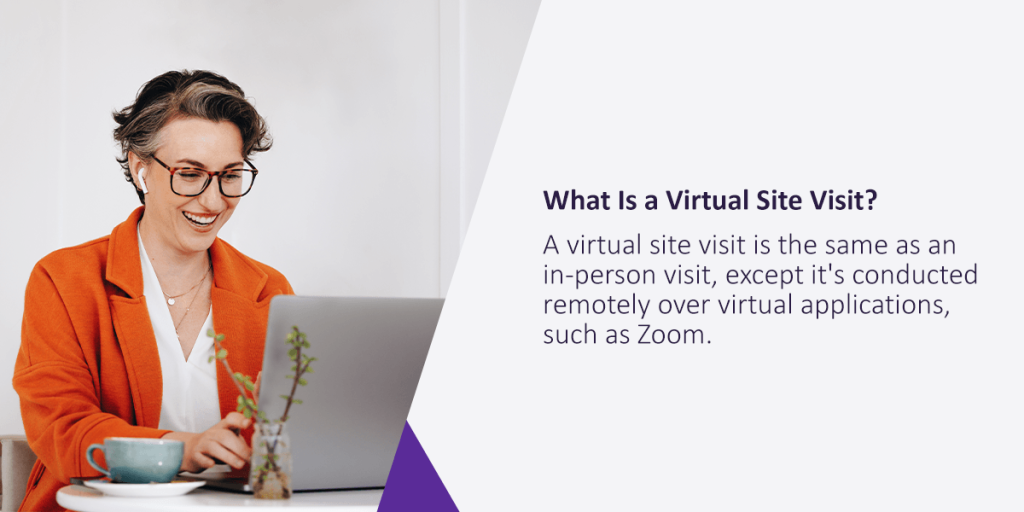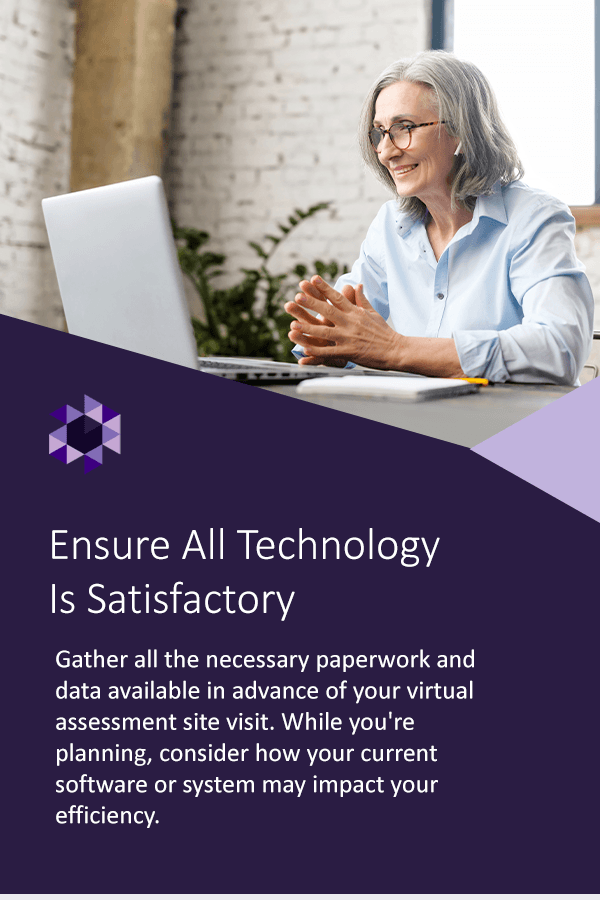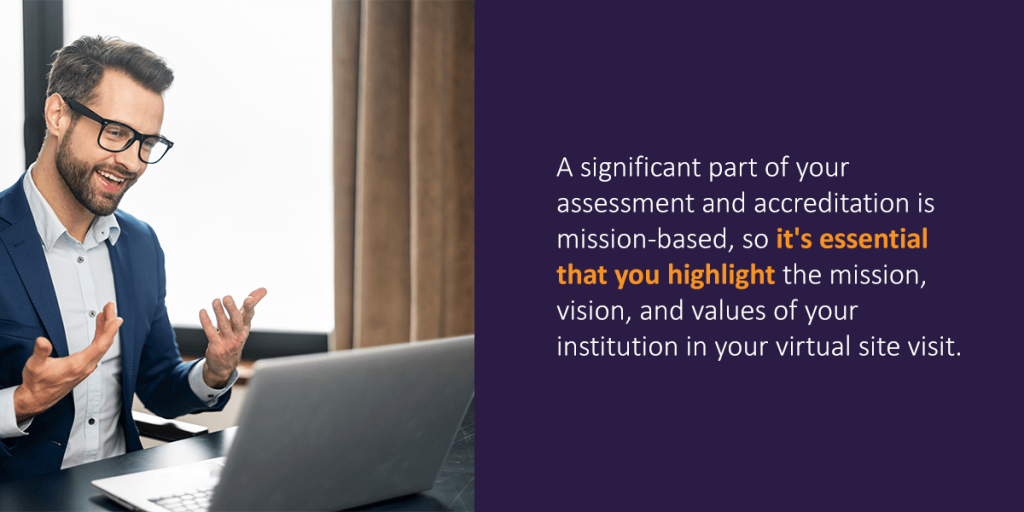
The COVID-19 pandemic made virtual and remote meetings the norm for an extended period, including higher education site visits. The pandemic not only caused a shift in how institutions handled course assignments and assessments, but also required an adjustment to accreditation visits and processes. Though many in-person activities have since resumed, virtual assessments may still be the convenient choice for some accreditation agencies.
Assessment data is still a critical component of a successful accreditation experience, regardless of how the agency conducts its site visit. Now is the time to reevaluate current processes and build a strong digital foundation that will carry your institution through whatever the future brings — but where should you begin? Let’s explore some valuable tips to help ensure a successful accreditation visit.
What Is a Virtual Site Visit?

A virtual site visit is the same as an in-person visit, except it’s conducted remotely over virtual applications, such as Zoom. Though the virtual site visit agenda is a bit different, it generally follows the standard format and activities of an in-person assessment.
Accreditation agencies can review institutions and their programs virtually by speaking with various participants, including:
- Faculty
- Staff
- Administration
- Provosts
- Deans
- Students
While conducting these interviews, the agency will want to collect relevant data and documents for review. This helps them ensure the college or university aligns with all current requirements and standards. Accreditation field representatives may also ask administrators about suggested institutional improvements.
Tips for Preparing for a Virtual Site Visit
Preparing for a site visit assessment, whether it’s virtual or in person, takes a bit of care. As higher education institution administrators, you and your staff strive for compliance and excellence every day. Planning and keeping everything organized can help you gain and keep the accreditation you continuously work toward. Here’s a site visit checklist of everything you need to consider before the big day.
1. Prepare in Advance
Being well-prepared is the key to achieving a successful virtual site visit. Because these assessments are so important, your staff should devote plenty of time to getting everything together. As soon as you’re aware of the date and time of your site visit, even if it’s a year away, create a list of everything you and your administration will need to ensure a smooth experience.
Whether you need to collect certain student and institution data over the next few months, round up a list of participants for interviews, or consider how you’ll showcase your institution virtually, it’s critical to think ahead. For instance, in-person visits usually come with a tour, but doing this virtually involves some planning for technology needs.
2. Conduct an Internal Evaluation
The most effective method for finding ways to improve your institution is by conducting a self-evaluation. Also called a self-study, this step is often required for accreditation agencies to examine the structure and effectiveness of your institution.
In this self-study, you can pull faculty from various departments to monitor and report on critical processes, including program goals and outcomes, and check for any missing or incorrect data you would need on the day of your assessment. This enables you to collect results, gain insights, and analyze them to determine the actions that will move the success of your students and institution forward.
3. Ensure All Technology Is Satisfactory

Gather all the necessary paperwork and data available in advance of your virtual assessment site visit. While you’re planning, consider how your current software or system may impact your efficiency. For example, if your college or university is still using an outdated legacy system or has older electronic equipment, you may end up with lags in your virtual meeting.
It can be a challenge to scan all of your documents and upload them digitally if your hardware and software are not up to the task. Uploading items to a computer that’s over a decade old could take you several days to complete, leading to burnout and mistakes. This drawback can add unnecessary stress to your preparation. Plan accordingly by ensuring your technology is up to date and ready to evolve with your institution.
4. Review Virtual Etiquette With All Participants
Many virtual assessment site visits for accreditation will require several or more participants to speak in the virtual room. Whether the accreditation body wants you to include program participants, students, volunteers, staff, faculty, or professors, it’s important to prepare them ahead of time and clarify your expectations. You can schedule a meeting or prep call with everyone who will be in attendance to walk them through the details.
This prep should include reviewing virtual etiquette, such as ensuring every participant finds a quiet, well-lit location for their virtual meeting. Be sure to instruct them not to eat or do anything disruptive during the assessment, mute themselves when they’re not speaking, and promptly exit the meeting when they’ve finished their interview.
5. Demonstrate Compliance and Commitment to Improvement
The most important aspect of your virtual site assessment is demonstrating to the accreditation agency that your institution is compliant and constantly looking for ways to improve. To demonstrate compliance, you’ll need to collect the required data and key metrics required for accreditation. Having efficient technology and assessment tools to boost your strategy and streamline this process is particularly beneficial.
In your self-study, or self-evaluation, consider highlighting how you have found ways to improve in the past that increased the quality of your institution or a particular program. This will show the accreditation agency that you’re serious about assessment and that you use these points of review to make valuable improvements. Having a paper trail of this information also demonstrates that you continuously evaluate your standards and take corrective action when needed to boost learning outcomes and support the values of your institution.
6. Highlight the Story and Mission Statement of Your Institution
A significant part of your assessment and accreditation is mission-based, so it’s essential that you highlight the mission, vision, and values of your institution in your virtual site visit. During your assessment, be sure to pinpoint the mission of your school and why it’s important to everyone at your institution.

Tell the story of your school and discuss the challenges and successes it’s had along the way. Explicitly describe how your faculty and students are accomplishing what your institution set out to do and what it hopes to do in the future. Ensure your definitions align with the programs at your school and what they deliver.
7. Go Digital
To help your future assessments go as smoothly as possible and reduce stress, consider implementing accreditation readiness tools. Such software acts as a central home for all your assessment, accreditation, program review, and strategic planning processes.
With these digital solutions, your institution can maintain compliance, uphold transparency, and provide clear guidance for all stakeholders. The right tools for data collection and analysis let your administrations pull data when it’s needed and exceed the expectations of your accreditors.
Simplify the Process With Accreditation Software From Watermark
Preparing for an accreditation, whether in person or virtual, takes time. As a higher education institution administrator, you know how important it is to keep all records and documents organized and easily retrievable for moments like this. If you’re still relying on an outdated legacy system, it may fail when you need it most. At Watermark, we provide higher education institutions like yours with data collection, measurement, and analysis software specifically for assessment and accreditation purposes.
With over 20 years of experience and knowledge in the industry, we’ve developed the tools you need to stay compliant and streamline assessment site visits. It’s our goal to help you drive institutional improvement efforts with a centralized platform for all your institutional research and planning, reporting, and accreditation needs. To learn more about how you can create a solid foundation for meaningful assessment across your institution, request a demo today.















































































































































































































































































































































































































